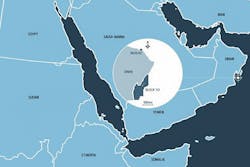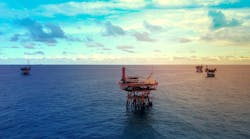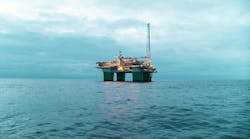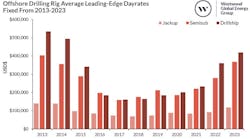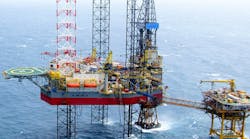Bruce Beaubouef Houston
Bahrain reports potentially giant offshore oil discovery
Bahrain’s National Oil and Gas Authority has announced a potentially giant offshore oil discovery in the Khalij al-Bahrain basin.
This follows the award of a contract last year to Schlumberger to drill two offshore exploration wells.
Tom Quinn, senior analyst, Middle East upstream, at Wood Mackenzie, said: “We understand the first well encountered oil – it was completed in October 2017 and is located to the south of Bahrain, not far from the Saudi maritime border.”
Another well encountered deep gas in two accumulations below the Bahrain field. Official estimates for the resources suggest 81.5 Bbbl in-place for the oil discovery, and 13.7 tcf for the deep gas find.
“While the scale of discoveries is very large,” Quinn suggested, “more information is needed to establish how much of the resource is commercially recoverable.”
According to a Reuters report, Halliburton will drill two appraisal wells later this year to further evaluate reservoir potential, optimize completions, and initiate long-term production.
“Core analysis by Schlumberger suggests the oil formation could be classified as a borderline conventional-unconventional play,” Quinn continued. “A tight reservoir means a low recovery factor and only a fraction of the 80-plus billion barrels is likely to be recoverable. The oil will also be technically challenging and potentially high cost to develop.”
Bahrain will likely approach international partners to contribute funding and technical expertise for a potential development, but Quinn pointed out that the country’s previous oil contracts came with severe fiscal terms by international standards, and the IOC partners involved only achieved meagre returns. So new fiscal terms would be needed to attract suitable partners. Production is declining from Bahrain’s onshore field, currently around 45,000 b/d, while output from the Abu Sa’fah field shared with Saudi Arabia is 150,000 b/d.
The country also imports crude from Saudi Arabia through a pipeline that is currently being expanded – deliveries are to the Sitra refinery.
Bahrain is installing an FSRU to import LNG with a nominal capacity of 800 MMcf/d, due to come online early next year, and the country will probably need the entire gas import capacity until the new discoveries come onstream.
KCA Deutag starts long-term drilling at Gullfaks
KCA Deutag has started drilling operations with the new Cat J jackupAskeladden on the Gullfaks field in the Norwegian North Sea.
Statoil and its co-licensees acquired the newbuild rig, constructed in South Korea, for production and exploration drilling on Gullfaks satellites. Start-up had to be delayed until last month, due to weather-related issues.
Gunnar Nakken, head of the operations west cluster at Statoil said, the Askeladden would help extend Gullfaks’ productive life beyond 2030.
Initially it is plugging two existing wells with the spare slots then re-use for new well targets. One well will be side tracked into the Rimfaks Lomvi prospect at a depth of 4,200 m (13,779 ft) to explore for new hydrocarbon deposits.
Currently Statoil plans to use the rig for 11 wells during its first two years of operation. KCA’s contract runs for eight years.
According to drilling superintendent Carlos Kauffmann: “This is a very exciting rig which is well prepared for a digitalized future, and can start using almost any new technology. It has a subsea blowout preventer, which is not common on jackup rigs. That makes it an excellent working platform for improved work efficiency, and reduces our need to wait on weather. Our challenge will be to utilize the weather windows properly, and avoid moving the rig in the winter season.”
KCA Deutag’s sister rig the Askepott began development drilling at Oseberg Vestflanken 2 in the North Sea in February.
The Karamah#1 well has been shown to have a 5-m (16-ft) oil-bearing interval, with various hydrocarbon shows detected in various stratigraphic zones. (Courtesy Rex International Holding)
Offshore Oman field slated for production next year
Rex International Holding has issued an update on the exploration program of its subsidiary Masirah Oil in block 50 offshore Oman.
Last year, Masirah completed drilling of the Karamah#1 well, with a 5-m (16-ft) oil-bearing interval identified on wireline logs and hydrocarbon shows detected in various stratigraphic zones.
Although the result was not commercial, the well did confirm the presence of a working petroleum system in the block.
In addition, Masirah performed a screening development feasibility on the earlier GA South#1 discovery, concluding that commercial production could be viable.
It also started reprocessing of the seismic data to improve stratigraphic resolution and structural imaging of the discovery. And after integrating the results of Karamah#1 well and reprocessing these into an improved understanding of the basin, it concluded that several promising prospects are located within a short distance of the GA South#1.
Plans going forward include finalizing development concept studies for GA South#1 before mid-year, with a view to starting production in early 2019; and completing mapping of the block ahead of further potential drilling of prospects that could either be produced in parallel or sequentially with GA South#1. The exploration and production-sharing agreement for block 50 has been extended until 2020.
OMV finds gas, condensate near Åsgard
OMV Norge has discovered gas condensate in separate intervals via a high-pressure/high-temperature exploration well in the Norwegian Sea. The semisubmersibleDeepsea Bergen drilled well 6506/11-10 in 342 m (1,122 ft) water depth in license PL 644 B, 5 km (3.1 mi) northwest of the Statoil-operated Morvin field in the central Norwegian Sea and 245 km (152 mi) northwest of Kristiansund.
The well’s primary and secondary exploration targets were to prove petroleum in the Lower Cretaceous (Lange formation) and Middle Jurassic (Garn formation), respectively. In the prime Lower Cretaceous (Lange formation) target, named Hades, the well encountered a gas/condensate column totaling around 35 m (115 ft), of which 15 m (49 ft) was sandstone reservoir. Within the Mid-Jurassic (Garn formation), named Iris, the well penetrated a 95-m (311-ft) gas/condensate column, with the gas/water contact located 4,295 m (14,091 ft) below sea level.
Collectively, the recoverable resource appears to be in the range 40-245 MMboe, OMV said. The company and its partners plan further evaluation ahead of a potential development – the Åsgard complex is 20 km (12 mi) to the southeast, which already transports gas and condensate to various parts of Europe.


